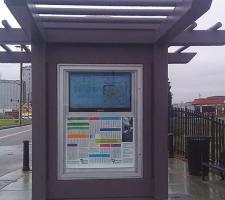
David Crawford tracks gains from growing mobile phone use.
Exponentially widening mobile phone ownership is opening up the field to new ways of obtaining and disseminating better travel information from and to public transport users, via for example social media and tracking riders' phones. Over 50 US transit agencies, including major actors such asMelissa Jordan, a senior marketing representative with BART, an early adopter, says: "Twitter humanises our brand. That comes up quite a bit in the feedback we get from riders, who feel a more personal connection when they can communicate with us in real time, and know that we're listening and answering their questions," "The trick for transit operators," says Daniela Baker, a US social media advocate who grew up in Europe and experienced the greater role played there by public transport, "is not just to be on the lookout for travellers' suggestions and opinions but also to notice how the whole communication task is evolving with the invention of new tools and new ways of using them. The hardest challenge for transit professionals is simply to be open to innovation arising from the social media sphere." One operator that has clearly taken this message on board is Houston Metro, in Texas, whose vice president of communications and marketing, George Smalley says: "The advent of social media has helped me change my strategy as a communications professional.
"Before I had to urge the news media to carry my messages but they were always filtered and sometimes distorted it.
Now I have new media available to send my messages directly to my audience."
Setting out options
An important annual US focus for highlighting these efforts is the American Public Transportation Association (Arizona was one energetic contributor, with the City of Tempe, in the Greater Phoenix Region, using Twitter and Facebook to encourage residents to choose public transit, by highlighting the cost savings available from using alternatives to their cars. (According to its latest APTA Transit Savings Report, members of a two-person household can save an average of US$834.00 per month by taking public transportation and living with one fewer cars.) The market seems to be there for the taking. Results of a poll published in March 2010 by US national neighbourhood improvement campaign Smart Growth America and transport lobbyist Transportation for America found that Americans actively want more transportation options.
Passengers as data providers
US company MV Technology has developed innovative public transport monitoring and passenger information services using all-onboard GPS equipment - including (anonymously) riders' own smartphones, as well as operators' mobile data computers, as growing numbers of transit agencies run GPS-equipped vehicles.
TimePoint is hosted on MV's server and integrates onboard technology to interface with GPS-based systems to enable tracking of vehicle locations, monitor on-time performance, record dwell times and capture data that can be used to refine schedules and improve delivery.
Says chief information officer Marsha Moore: "It can make use of any GPSenabled system that is available on the bus. A phone can transmit GPS locations every 30 seconds." MV Technology is a spin-off of California-headquartered MV Transportation, the US's largest privately owned transportation contractor and para-transit provider, which originally developed the software to gain feedback on its own performance levels. TimePoint is designed to enable transit agencies to assess how well their buses are running by performing predictive analysis, extracting historical data and showing what the schedule should be to meet goals.
It also aims to make agencies more environmentally friendly by cutting down on idling time, by providing the data needed to get rid of excess provision in route schedules. Rider information is available via the web, smartphones, texting or kiosks in, for example, transport interchanges or shopping malls.
Riders can also have automatic alerts via MV's central messaging system. For phones with cameras, each bus stop sign carries a barcode-type symbol, which riders can photograph to obtain the information they need.
The system is now operational in 23 US locations, including the Anaheim Resort Transit System's Disneyland shuttle service in California.However, 73 per cent were frustrated by the transportation options that were currently available. Only one in five of those polled had taken public transit during the previous month, but they indicated they would like to use it more.
Private investigations
Another study, by Nielsen Research, into the influence of social media as an information source, found it highly trusted by the public, ahead of websites, TV/radio and publications.
Says Baker: "Google Transit is now the go-to source for routes and schedules over much of the world, and many transit agencies are increasingly deferring to Google rather than maintaining their own expensive systems.
"The main relevance is that Google's standard public data formats allow anyone to access route, schedule and even real-time location data. As a result, entrepreneurs have been able to develop their own web and mobile phone applications for customising transit information and allowing users to opt for whatever suits their own particular travel needs.
Earlier in 2011, one New Yorker, Alex Bell, developed the SubwayArrival iPhone app, which gives live updates on the location of trains on the New York subway (metro), without calling on any of the
It notes iPhones that swap to a different cell base-station, or disappear due to a lost signal and then reappear some distance away in a relatively short time, showing the completion of a journey. Combining this (always anonymous) information from a number of phones allows the base computer to model the movements of subway trains. Users can then pull up a map of their area and see the train moving on a streetmap of the city. The app also gives service status updates.
Again in New York, the
Says head of marketing Dylan Goelz: "We think of Roadify as the first comprehensive 'social transportation' company." In April 2011, the company won a US$10,000 prize in the New York City BigApps Awards, co-sponsored by the NYC Economic Development Corporation and Department of Information Technology and Telecommunications, along with BMW.
European developments
In Europe, global transport consultantPhil Berczuk, the company's head of design, sees the travelling public as a valuable source of real time data, even if they are unaware of it.
"The rise in smart phone popularity has empowered them to become active 'smart travellers', he says." He hails the increasing evidence of social media being used in-trip both to report on, and share detail of, travel issues through both 'official' Tweets from operators and crowd-sourced Tweets or Facebook posts.
He cites the winter 2010 weather disruption in the UK, when the national rail information system was mostly switched off, and the 4 May 2011 fatal accident at Clapham Junction, a major interchange in south-west London, as evidence of Twitter's value as a source of real-time travel information.
Speaking at a 2011
Social media, he believes, can also deliver cost and efficiency savings on the installation and maintenance of travel information infrastructure (such as kiosks). Tweets can be built into journey planner results - both 'official' and crowd-sourced - and pushed out as up-to-date information to registered users.
At major events, they can be used to generate crowd-sourced disruption maps.
In the long term, he sees social media as "paving the way for a multi-modal onestop- shop for travel information at the core of sustainable 'smart cities'.RSS













